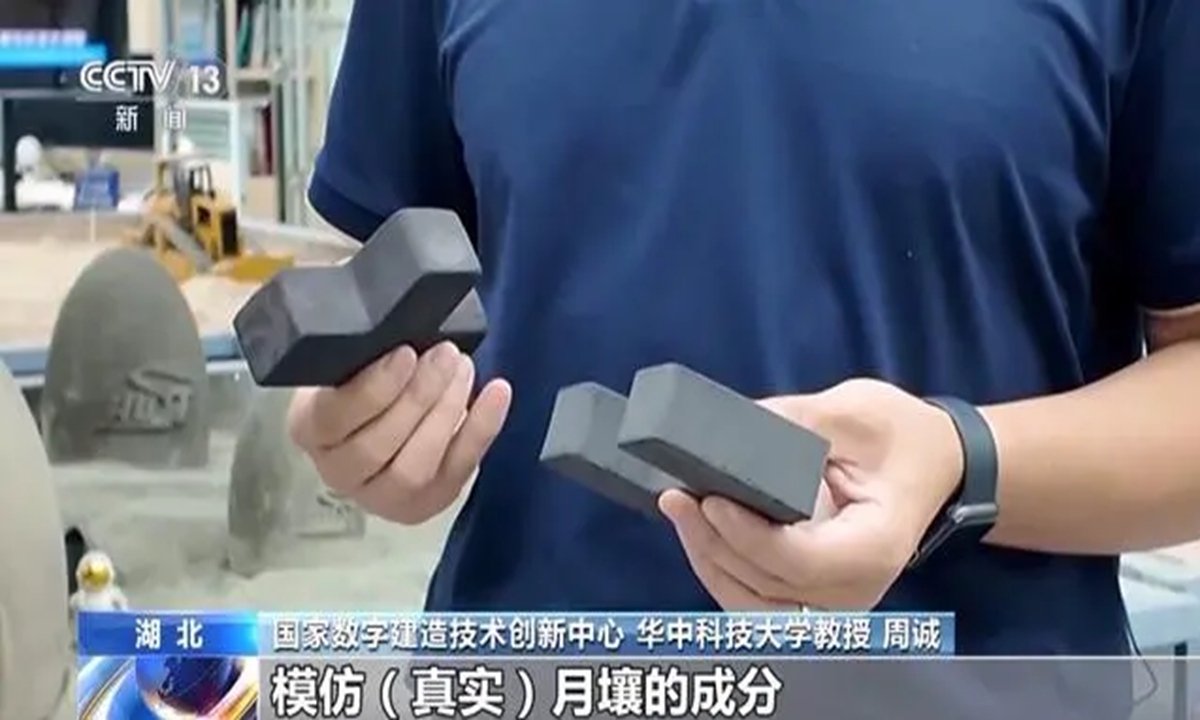A researcher presents bricks made from simulated lunar soil, a potential building material for future habitats on the moon. The bricks have a density comparable to ordinary ones, but their compressive strength exceeds that of standard red bricks and concrete bricks by more than three times. Photo: CCTV
Bricks made from simulated lunar soil, a potential building material for future habitats on the moon, are scheduled to be sent to China’s space station for exposure experiments, with the first brick expected to return to Earth by the end of 2025.
The bricks made from simulated lunar soil have a density comparable to ordinary bricks, but their compressive strength exceeds standard red bricks and concrete bricks by more than three times, with one square centimeter capable of supporting over a ton of weight, according to China Central Television ( CCTV).
The combination of these durable bricks uses plug-and-peg techniques, making them more suitable for the structural design of future lunar bases, said Zhou Cheng, a professor from the National Center of Technology Innovation for Digital Construction, as reported by CCTV.
However, building a house on the lunar surface may face challenges due to drastic temperature changes on the moon, with temperatures exceeding 180 C during lunar days and reaching -190 C at lunar night.
As the moon rotates and orbits, day and night occur on different parts of its surface, with the lunar day and night each about two Earth weeks long.
Without atmospheric protection, significant levels of cosmic radiation and many micrometeorites would also strike the lunar surface, and there is frequent moonquake activity. All of these will place high demands on the mechanical, thermal and radiation resistance properties of the lunar surface construction materials.
As these bricks will travel to the Tiangong space station aboard the Tianzhou-8 cargo vehicle to test their suitability for building habitats on the moon, Zhou outlined three key characteristics of the bricks that will be verified, including the potential degradation of their mechanical properties, their heat retention and insulation efficiency and their ability to withstand cosmic radiation on the moon.
The whole process of making such bricks by vacuum hot pressing and sintering is divided into three steps, Zhou explained. Scientists must weigh the simulated lunar soil and then place it in the mold according to its weight. They have to press it into the mold container as the lunar soil is very loose.
The researcher will then put it into the vacuum hot press oven. After locking the entire vacuum experiment apparatus, it can be heated and sintered, Zhou introduced.
The lunar soil material that the researchers modeled in the laboratory is similar to Earth’s soil, which is dispersed. To process it, researchers must expose it to high temperatures.
Zhou noted that the process does not involve additional material additives, making it a very promising construction method for future lunar base development, allowing the use of in-situ resources on the moon, such as lunar soil, solar energy, minerals to build a house, eliminating the need to transport prefabricated building components from the ground.
Such an approach could greatly reduce the cost of lunar surface construction. These simulated bricks will be subjected to experiments in space to accumulate scientific data to build houses on the moon in the future, to optimize the actual scheme, according to CCTV.
Whether for scientific research or construction on the moon, transporting materials from Earth is impractical, Wang Yanan, editor-in-chief of Beijing-based Aerospace Knowledge magazine, told the Global Times on Sunday. Given the current capacity of rockets, the valuable space at each launch should be reserved for personnel, essential equipment and supplies.
Therefore, lunar soil is an abundant and readily available building material that solves the problem of obtaining raw materials in situ on the moon, Wang noted.
The total planned exposure period for the bricks is three years, so every year scientists will return a sample panel exposed on the space station to Earth and conduct related experiments, Zhou said.
The research team also designed the bricks in two shapes: columnar and flaky. The columnar lunar soil rocks are primarily intended for mechanical testing, while the larger exposed flakes are used to assess thermal and radiation effects, according to CCTV.
In addition to their different shapes, these bricks are made from five simulated compositions of lunar soil and undergo three different sintering processes, providing more accurate scientific data for the construction of future lunar bases.
China’s lunar exploration program will carry out two more launch missions to lay the groundwork for the International Lunar Research Station (ILRS), with the first launch expected as early as 2026, the China National Space Administration announced in September.
